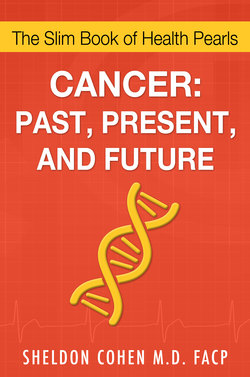Читать книгу Cancer: Past, Present, and Future - Sheldon Cohen M.D. FACP - Страница 6
На сайте Литреса книга снята с продажи.
CHAPTER 4 Cancer without disease
ОглавлениеMedicine, to produce health, has to examine disease; and music, to create harmony,
must investigate discord
Plutarch
A.D. 46-120
We all get cancers on a daily basis, and we get them often. They arise in all parts of our bodies, grow to approximately one to two cubic millimeters, consist of thousands to millions of cells and remain dormant; they do not metastasize (spread to other parts of our bodies), they stay in place, growth inhibited, are harmless in this stage, and are known as in situ cancer, or cancer without disease. Why don’t they grow and spread like cancers are supposed to do? The cells of these “cancers” only grow and divide to a certain level and when they reach a point where their tumor mass exceeds their blood and oxygen supply, growth and cell division ceases. To understand the reason for this growth inhibition requires an understanding of angiogenesis (angio…blood vessels; genesis…growth).
Angiogenesis is a vigorous process during fetal growth in utero. A developing fetus cannot develop without blood vessels, so growth of these blood vessels is vigorous and extensive. Not so after full fetal development when the only time there is blood vessel growth is during pregnancy (growth of placenta), during active repair of injuries, and the process of menstruation when the uterine lining grows new blood vessels every month.
But all cells, including cancer cells, want to grow and develop and they do what they can to activate the process of angiogenesis; the production of new blood vessels to feed the dormant tumor of the necessary blood and oxygen to grow and expand beyond the one to two cubic mm growth limit nature has set on the cluster of dormant cancer cells. How do they do this? Researchers discovered that these dormant cancer cells release proteins capable of activating the process of angiogenesis. At least a dozen different protein molecules have been identified as being angiogenic (can trigger new vessel growth). The two main ones are: vascular endothelial growth factor (VEGF) and basic fibroblastic growth factor (bFGF). In addition, to these stimulating vascular growth factors, cancer cells also liberate vascular inhibiting growth factors setting up a battle between vascular growth and vascular inhibition, mostly creating a neutral stalemate where the early cancers do not grow and spread, remaining at their one to two cubic millimeter stable, non-growing level.
The pioneer in this work was Judah Folkman who developed this thesis in 1971.
As long as the proangiogenic factors and antiangiogenic factors balance, there will be no growth, but if proangiogenic factors are able to predominate, cancer growth (and even benign tumor growth) will be able to “take off.”
It took until the late 1980’s for the scientific community to embrace Folkman’s concepts that cancer growth and spread depended upon angiogenesis. To this point, treatment of cancer focused on killing or eliminating cancer cells. And it still does: eliminating them by surgical approaches; killing them by radiation or chemotherapy. Angiogenesis slowly evolved into an approach not focusing on the cancer cell itself, but rather focusing on a factor that “fed” the cancer, in essence starving it to death. By 2004, the Food and drug Administration approved 10 drugs that inhibit angiogenesis, used not only against cancer, but also against some benign diseases such as age-related macular degeneration where angiogenesis also takes place. Progress is slow and ongoing, but the magic bullet hoped for in the angiogenic inhibiting therapeutic approach is not the hoped for cure.
